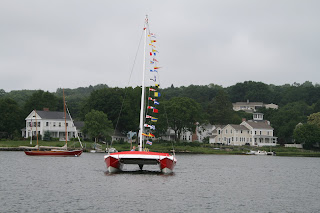 This is the insulation plug for the hatch. This ice box has 5" of insulation all around it. When you insert this hatch plug it settles down into the hole slowly as the air squeezes by. Nice fit.
This is the insulation plug for the hatch. This ice box has 5" of insulation all around it. When you insert this hatch plug it settles down into the hole slowly as the air squeezes by. Nice fit. With the plug removed the shelf is visible below the hatch.
With the plug removed the shelf is visible below the hatch.
The wooden square with the handle is the interior access to the main ice box. It also has 5" of insulation on it and slopes downward into the box to minimize cold leakage. Also visible in this photo is the propane burner and the galley sink. Not visible here is the foot pump below the shelf below the icebox access.
 Adjacent to the galley side companionway is this cooler in the cockpit. While it only has 2" of insulation it too worked very well and is very convenient.
Adjacent to the galley side companionway is this cooler in the cockpit. While it only has 2" of insulation it too worked very well and is very convenient. Here is the trap door to the box which hangs below the forward deck to store the anchor rode.
Here is the trap door to the box which hangs below the forward deck to store the anchor rode.
The box handily holds 20' of 5/16" chain and 150' of 7/16" anchor line.
 Here is a view of the box from underneath and forward. Also in the fore ground is the roller for the Rocna anchor .
Here is a view of the box from underneath and forward. Also in the fore ground is the roller for the Rocna anchor . We have completed the outboard window change out and the results are good. More light is allowed into the cabin and there is a more open felling. This is the interior view.
We have completed the outboard window change out and the results are good. More light is allowed into the cabin and there is a more open felling. This is the interior view. Here's a fairly close view of the window from the outside. You can also clearly see the dead eyes and chainplates with terminators and the shroud lashings. The sliding hatch for the companionway is also very clear.
Here's a fairly close view of the window from the outside. You can also clearly see the dead eyes and chainplates with terminators and the shroud lashings. The sliding hatch for the companionway is also very clear.
A port side view of Abaco showing the window and also the bimini. The bimini was built for us by High Seas Fabrication of Stuart FL. They did a real great job for us. The bimini provides lots of shade, standing headroom and as an extra bonus good hand holds at crucial locations. We did however forget to put a window in to be able to see the mast head and mainsail leech. We will have to have this added.


















































